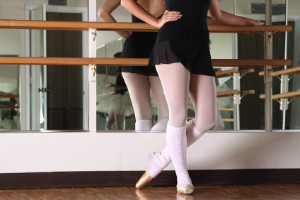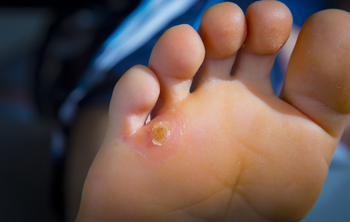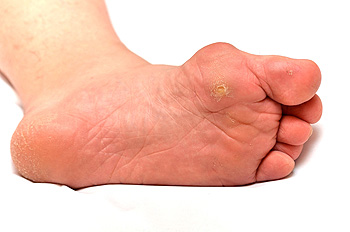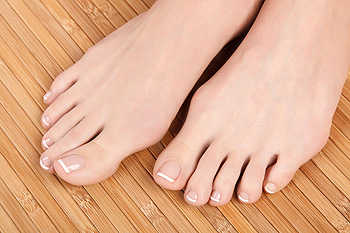Glen Allen Office
(804) 747-3380
 Ballet dancers may often experience painful and uncomfortable blisters, which may be a result of the type of ballet shoes that are worn. Most blisters develop because a portion of the skin rubs on the shoe, and this may cause friction to occur. It’s important to find a pointed shoe that fits perfectly, and this is often accomplished with the help of trained professionals. Research has shown it may be helpful to sprinkle powder inside the shoes, and this may aid in absorbing excess moisture, which may help in the prevention of blisters. If a blister has developed, and ballet dancing must continue, it is imperative to determine if the liquid inside the blister is clear. This must precede any lancing technique, followed by utilizing an antibiotic ointment, which may aid in preventing an infection. If you are frequently developing blisters that need treatment, it is advised to consult with a podiatrist who can properly assist you.
Ballet dancers may often experience painful and uncomfortable blisters, which may be a result of the type of ballet shoes that are worn. Most blisters develop because a portion of the skin rubs on the shoe, and this may cause friction to occur. It’s important to find a pointed shoe that fits perfectly, and this is often accomplished with the help of trained professionals. Research has shown it may be helpful to sprinkle powder inside the shoes, and this may aid in absorbing excess moisture, which may help in the prevention of blisters. If a blister has developed, and ballet dancing must continue, it is imperative to determine if the liquid inside the blister is clear. This must precede any lancing technique, followed by utilizing an antibiotic ointment, which may aid in preventing an infection. If you are frequently developing blisters that need treatment, it is advised to consult with a podiatrist who can properly assist you.
Blisters may appear as a single bubble or in a cluster. They can cause a lot of pain and may be filled with pus, blood, or watery serum. If your feet are hurting, contact one of our podiatrists of The Podiatry Center. Our doctors can provide the care you need to keep you pain-free and on your feet.
Foot Blisters
Foot blisters are often the result of friction. This happens due to the constant rubbing from shoes, which can lead to pain.
What Are Foot Blisters?
A foot blister is a small fluid-filled pocket that forms on the upper-most layer of the skin. Blisters are filled with clear fluid and can lead to blood drainage or pus if the area becomes infected.
Symptoms
(Blister symptoms may vary depending on what is causing them)
Prevention & Treatment
In order to prevent blisters, you should be sure to wear comfortable shoes with socks that cushion your feet and absorb sweat. Breaking a blister open may increase your chances of developing an infection. However, if your blister breaks, you should wash the area with soap and water immediately and then apply a bandage to the affected area. If your blisters cause severe pain it is important that you call your podiatrist right away.
If you have any questions, please feel free to contact one of our offices located in Richmond and Glen Allen, VA . We offer the newest diagnostic and treatment technologies for all your foot care needs.
 A corn on the foot is described as a small area of hardened skin. Friction is generally the cause of the formation of corns, and they may develop as a result of wearing shoes that do not fit properly or not putting socks on while shoes are worn. Corns may typically produce pain, and comfort may be obtained after a protective pad is applied to the corn. Additional relief may be found after soaking the foot in warm water, followed by utilizing a pumice stone, which may be helpful in removing the hardened skin. If the corn is not diminishing in size after these treatments are performed, it is suggested to seek the counsel of a podiatrist who can properly remove the corn.
A corn on the foot is described as a small area of hardened skin. Friction is generally the cause of the formation of corns, and they may develop as a result of wearing shoes that do not fit properly or not putting socks on while shoes are worn. Corns may typically produce pain, and comfort may be obtained after a protective pad is applied to the corn. Additional relief may be found after soaking the foot in warm water, followed by utilizing a pumice stone, which may be helpful in removing the hardened skin. If the corn is not diminishing in size after these treatments are performed, it is suggested to seek the counsel of a podiatrist who can properly remove the corn.
If you have any concerns regarding your feet and ankles, contact one of our podiatrists of The Podiatry Center. Our doctors will treat your foot and ankle needs.
Corns: What Are They? and How Do You Get Rid of Them?
Corns can be described as areas of the skin that have thickened to the point of becoming painful or irritating. They are often layers and layers of the skin that have become dry and rough, and are normally smaller than calluses.
Ways to Prevent Corns
There are many ways to get rid of painful corns such as wearing:
Treating Corns
Treatment of corns involves removing the dead skin that has built up in the specific area of the foot. Consult with Our doctors to determine the best treatment option for your case of corns.
If you have any questions please feel free to contact one of our offices located in Richmond and Glen Allen, VA . We offer the newest diagnostic and treatment technologies for all your foot and ankle needs.
 A corn on the foot is described as a small area of hardened skin. Friction is generally the cause of the formation of corns, and they may develop as a result of wearing shoes that do not fit properly or not putting socks on while shoes are worn. Corns may typically produce pain, and comfort may be obtained after a protective pad is applied to the corn. Additional relief may be found after soaking the foot in warm water, followed by utilizing a pumice stone, which may be helpful in removing the hardened skin. If the corn is not diminishing in size after these treatments are performed, it is suggested to seek the counsel of a podiatrist who can properly remove the corn.
A corn on the foot is described as a small area of hardened skin. Friction is generally the cause of the formation of corns, and they may develop as a result of wearing shoes that do not fit properly or not putting socks on while shoes are worn. Corns may typically produce pain, and comfort may be obtained after a protective pad is applied to the corn. Additional relief may be found after soaking the foot in warm water, followed by utilizing a pumice stone, which may be helpful in removing the hardened skin. If the corn is not diminishing in size after these treatments are performed, it is suggested to seek the counsel of a podiatrist who can properly remove the corn.
If you have any concerns regarding your feet and ankles, contact one of our podiatrists of The Podiatry Center. Our doctors will treat your foot and ankle needs.
Corns: What Are They? and How Do You Get Rid of Them?
Corns can be described as areas of the skin that have thickened to the point of becoming painful or irritating. They are often layers and layers of the skin that have become dry and rough, and are normally smaller than calluses.
Ways to Prevent Corns
There are many ways to get rid of painful corns such as wearing:
Treating Corns
Treatment of corns involves removing the dead skin that has built up in the specific area of the foot. Consult with Our doctors to determine the best treatment option for your case of corns.
If you have any questions please feel free to contact one of our offices located in Richmond and Glen Allen, VA. We offer the newest diagnostic and treatment technologies for all your foot and ankle needs.
Read more about Corns and Calluses A bunion is described as a bony protrusion that forms on the side of the big toe. It may be unsightly and uncomfortable and is generally considered to be a deformity. Research has shown that specific bone structure, which may cause bunions to develop, may be inherited, in addition to having ailments that may include flat feet. Additionally, obesity and pregnancy may play a significant role in the formation of bunions, and this may be a result of the added weight the feet must endure. If you choose to wear shoes that do not have adequate room for the toes to move about in, a bunion may develop, which may lead to other foot conditions such as corns and calluses. If you notice a bump on the side of your big toe, it is suggested to seek the counsel of a podiatrist, so a proper diagnosis can be performed.
A bunion is described as a bony protrusion that forms on the side of the big toe. It may be unsightly and uncomfortable and is generally considered to be a deformity. Research has shown that specific bone structure, which may cause bunions to develop, may be inherited, in addition to having ailments that may include flat feet. Additionally, obesity and pregnancy may play a significant role in the formation of bunions, and this may be a result of the added weight the feet must endure. If you choose to wear shoes that do not have adequate room for the toes to move about in, a bunion may develop, which may lead to other foot conditions such as corns and calluses. If you notice a bump on the side of your big toe, it is suggested to seek the counsel of a podiatrist, so a proper diagnosis can be performed.
If you are suffering from bunion pain, contact one of our podiatrists of The Podiatry Center. Our doctors can provide the care you need to keep you pain-free and on your feet.
What Is a Bunion?
Bunions are painful bony bumps that usually develop on the inside of the foot at the joint of the big toe. As the deformity increases over time, it may become painful to walk and wear shoes. Women are more likely to exacerbate existing bunions since they often wear tight, narrow shoes that shift their toes together. Bunion pain can be relieved by wearing wider shoes with enough room for the toes.
Causes
Symptoms
In order to diagnose your bunion, your podiatrist may ask about your medical history, symptoms, and general health. Your doctor might also order an x-ray to take a closer look at your feet. Nonsurgical treatment options include orthotics, padding, icing, changes in footwear, and medication. If nonsurgical treatments don’t alleviate your bunion pain, surgery may be necessary.
If you have any questions, please feel free to contact one of our offices located in Richmond and Glen Allen, VA . We offer the newest diagnostic and treatment technologies for all your foot care needs.
 When the sugar levels in the blood become elevated, the medical condition that is known as diabetes may occur. The feet may become affected as a result of this, and proper care must be given, which may avoid uncomfortable and painful foot ailments. These may include diabetic neuropathy, which may make it difficult to feel any wounds or cuts that may be present, or peripheral vascular disease, which may limit blood flow to the feet. Research has shown that foot conditions that are associated with diabetes will benefit from effective treatment methods when implemented. These may include properly taking care of wounds or infections that may have developed, in addition to possibly wearing a boot, which may relieve pressure off the foot. If you are a diabetic patient, it is suggested that you consult with a podiatrist as quickly as possible who can properly monitor this condition, which may affect the feet.
When the sugar levels in the blood become elevated, the medical condition that is known as diabetes may occur. The feet may become affected as a result of this, and proper care must be given, which may avoid uncomfortable and painful foot ailments. These may include diabetic neuropathy, which may make it difficult to feel any wounds or cuts that may be present, or peripheral vascular disease, which may limit blood flow to the feet. Research has shown that foot conditions that are associated with diabetes will benefit from effective treatment methods when implemented. These may include properly taking care of wounds or infections that may have developed, in addition to possibly wearing a boot, which may relieve pressure off the foot. If you are a diabetic patient, it is suggested that you consult with a podiatrist as quickly as possible who can properly monitor this condition, which may affect the feet.
Diabetic foot care is important in preventing foot ailments such as ulcers. If you are suffering from diabetes or have any other concerns about your feet, contact one of our podiatrists from The Podiatry Center. Our doctors can provide the care you need to keep you pain-free and on your feet.
Diabetic Foot Care
Diabetes affects millions of people every year. The condition can damage blood vessels in many parts of the body, especially the feet. Because of this, taking care of your feet is essential if you have diabetes, and having a podiatrist help monitor your foot health is highly recommended.
The Importance of Caring for Your Feet
Patients with diabetes should have their doctor monitor their blood levels, as blood sugar levels play such a huge role in diabetic care. Monitoring these levels on a regular basis is highly advised.
It is always best to inform your healthcare professional of any concerns you may have regarding your feet, especially for diabetic patients. Early treatment and routine foot examinations are keys to maintaining proper health, especially because severe complications can arise if proper treatment is not applied.
If you have any questions please feel free to contact one of our offices located in Richmond and Glen Allen, VA . We offer the newest diagnostic and treatment technologies for all your foot and ankle needs.